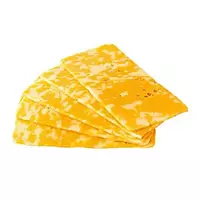Marble cheese

Such a food product as cheese leads to the list of the most common and popular in all corners of the planet Earth. In addition, the researchers believe that cheese can be safely considered one of the most ancient foods that are included in the constant diet of the vast majority of the world's inhabitants. The first acquaintance of people with cheese happened by pure chance.
In ancient times, people stored and transported milk in the stomachs of pets. Once, on a warm day, instead of milk, a person found cheese in bales, which turned out thanks to the natural fermentation process. Over time, people began to make their own sourdough for cheeses. At all times, various types of cheeses were in demand among all segments of the population.
Remarkably, many types of cheese that were previously considered "poor people's food" in modern times are included in the so-called "golden fund" of the world's cheese industry. Among the cheese variety presented on the shelves of domestic grocery stores, it is worth highlighting such a type of product as marble cheese. According to the method of production, as well as the composition, marble cheese can be classified as products obtained as a result of the use of rennet starter.
Composition of marble cheese
Marble cheese is a semi-hard rennet cheese that is produced from cow's milk. It is worth noting that marble cheese includes two separate types of product. Moreover, one of them is stained with the help of natural dyes. It is worth emphasizing that the calorie content of marble cheese depends on several factors and, above all, the composition of the initial components with which the product is subsequently produced.
The benefits of marble cheese
However, the average calorie content of marble cheese is 326 Kcal, which are per 100 grams of cheese product. The benefits of marble cheese, however, as well as other varieties of cheeses, are due to the vitamin-mineral composition of the product, which contains a significant amount of compounds useful for the human body.
The uniqueness of the benefits of marble cheese lies in the content of milk proteins and fats in the product, which in turn saturate the body with essential fatty acids such as Omega-3 or Omega-
6. In addition, marble cheese contains a number of amino acids and other certainly useful biologically active substances. True, in addition to the benefits, there is also harm to marble cheese for the human body, which is also hidden in the chemical composition of the product.
Harm of marble cheese
Often, in the production process of making marble cheese, food additives and dyes are used that do not always have a beneficial effect on the human body. In some cases, unscrupulous manufacturers use health-threatening reagents to color the product. The harm of marble cheese prepared without compliance with the standards may end in death for a person.
marble cheese 326 kCal
The energy value of marble cheese (Ratio of proteins, fats, carbohydrates - ju):
Proteins: 24.8 g (~ 99 kCal)
Fats: 25.2 g (~ 227 kCal)
Carbohydrates: 0 g (~ 0 kCal)
Energy ratio (bj | y): 30% | 70% | 0%
 Español
Español Français
Français Português
Português Русский
Русский 简体中文
简体中文 繁體中文
繁體中文 日本語
日本語 한국어
한국어 العربية
العربية Türkçe
Türkçe Қазақ
Қазақ Deutsch
Deutsch Italiano
Italiano Українська
Українська
